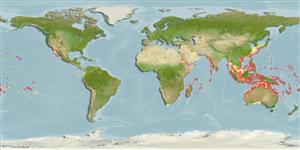Common names from other countries
Environment: milieu / climate zone / depth range / distribution range
Sinh thái học
Biển; Thuộc về nước lợ Cùng sống ở rạn san hô; Mức độ sâu 0 - 10 m (Ref. 86942), usually 0 - 10 m (Ref. 37816). Tropical; 40°N - 40°S
Indo-Pacific: East Africa to the Hawaiian, Marquesan, and Mangaréva islands, north to southern Japan, south to northern New South Wales, Australia. Also recorded from Southeast Atlantic: South Africa (Ref. 3972).
Bộ gần gũi / Khối lượng (Trọng lượng) / Age
Maturity: Lm ? range ? - ? cm
Max length : 66.0 cm TL con đực/không giới tính; (Ref. 1602)
Các tia vây lưng cứng (tổng cộng) : 0; Các vây lưng mềm (tổng cộng) : 0; Tia cứng vây hậu môn: 0; Tia mềm vây hậu môn: 0; Động vật có xương sống: 162 - 171. White to yellow with 25-30 black saddles (Ref. 3972).
Occurs in sandy areas and seagrass beds of both lagoon and seaward reefs. Uses its stiff pointed tail to rapidly burrow backwards into the sand when frightened (Ref. 37816). Benthic (Ref. 58302). Feeds on sand-dwelling fishes and crabs and prawns. Sometimes fully exposed when searching for prey (Ref. 30874). Rises to the surface to spawn (Ref. 37816).
Life cycle and mating behavior
Maturities | Sự tái sinh sản | Spawnings | Egg(s) | Fecundities | Ấu trùng
Rises to the surface to spawn. Once there, one or more males may seize a female by the back of the neck and remain attached for hours before spawning occurs.
Myers, R.F., 1991. Micronesian reef fishes. Second Ed. Coral Graphics, Barrigada, Guam. 298 p. (Ref. 1602)
IUCN Red List Status (Ref. 130435)
CITES (Ref. 128078)
Not Evaluated
Threat to humans
Harmless
Human uses
Các công cụ
Special reports
Download XML
Các nguồn internet
Estimates based on models
Preferred temperature (Ref.
115969): 24.4 - 29.2, mean 28.1 (based on 2893 cells).
Phylogenetic diversity index (Ref.
82804): PD
50 = 0.7500 [Uniqueness, from 0.5 = low to 2.0 = high].
Bayesian length-weight: a=0.00089 (0.00039 - 0.00204), b=3.00 (2.80 - 3.20), in cm Total Length, based on LWR estimates for this (Sub)family-body shape (Ref.
93245).
Mức dinh dưỡng (Ref.
69278): 3.1 ±0.3 se; based on diet studies.
Thích nghi nhanh (Ref.
120179): Trung bình, thời gian nhân đôi của chủng quần tối thiểu là 1.4 - 4.4 năm (Preliminary K or Fecundity.).
Fishing Vulnerability (Ref.
59153): Moderate to high vulnerability (46 of 100).
